THE BRITISH OVERSEAS RAILWAYS HISTORICAL TRUST
|  |
Reference Sources for Army Logistics and Transport Corps and their Commonwealth Counterparts
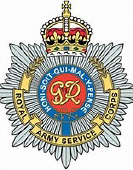
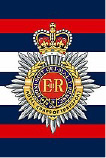
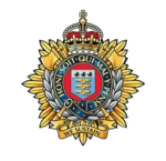
From left to right: cap badges of the Royal Army Service Corps, Royal Corps of Transport and Royal Logistic Corps
Following on from the earlier reference sources this document is to assist in research on Royal Corps of Transport Military Railways. You are encouraged to look at the other research pages for further ideas, as there may be some duplication of material and those pages will also give an overall history of the railway. Also, please look at the general research page as that contains many sources that may be of assistance.
A very brief history of the Royal Logistic Corps.
An army needs to be supplied with water, ammunition, forage, food, and other necessities in that order. Railways can bring the supplies from the base areas to behind the front line but cannot deliver it to the front line. It is the job of the RLC and its ancestors to deliver the supplies to a forward base where regimental transport can pick it up. Over the last two hundred years quite how the British Army achieved this has changed.
This needs be a very brief history, so we will not be describing all the name and role changes in detail.
Before the establishment of the first uniformed corps The Royal Waggoners in 1794 army transport had been carried out by contracted civilians. The Royal Waggoners only lasted a year before being disbanded, but in 1799 the Royal Waggon Corps was established and disbanded in 1833. Nothing then happened until 1855 and the Crimean War which led to the Land Transport Corps being raised.
By 1859, supply duties were the responsibility of the Commissariat (a uniformed civilian body, principally responsible for food, forage and fuel); while provision of arms, ammunition and other critical stores was the responsibility of the Military Store Department (formed following the abolition of the Board of Ordnance in 1855).
Control Department
In 1869, there was a major reorganisation of army supply and transport capabilities: the commissaries of the Commissariat and the officers of the Military Train were amalgamated together with the officers of the Military Store Department to form what was called the Control Department under a Controller-in-Chief.
From 1870, the Control Department was placed within the new Department of the Surveyor-General of the Ordnance, who took over as Controller-in-Chief. The Department of the Surveyor General of the Ordnance retained the Control Department and further restructured it into four new divisions superintended by a director: the first was the Supply and Transport Division (formed from the merging of the former commissariat, purveyors and barrack departments), the second was an Artillery and Stores Division (that absorbed the former contracts, clothing, ordnance and stores departments) and the third was a Contracts Division. The fourth division created was called the Control Establishments Subdivision that became responsible for the administration of the Control Department's staff.
Commissariat and Transport Department
In November 1875, the Control Department was abolished and its work in regard to field service was allocated to two new departments: the Commissariat and Transport Department and the Ordnance Store Department. Following failures in the Anglo-Zulu War, the Commissariat and Transport Department was disbanded in January 1880, and replaced with the Commissariat and Transport Staff.
Initially, the Commissariat and Transport Department remained part of the Department of Surveyor General of the Ordnance (in 1878 the Control Establishments Subdivision’s name was altered to the Commissariat and Transport Establishments Division under the supervision of a Commissary General). In 1887, however, the Department of the Surveyor General of the Ordnance and its head was abolished; its former functions were then distributed among the several divisions of the Military and Civil Departments: the work of the Supply and Transport Division was allocated to the Quartermaster General's Division.
Army Service Corps, 1888–1918
In December 1888, the Commissariat and Transport Staff and the Commissariat and Transport Corps amalgamated to form a new Army Service Corps, and for the first time officers and other ranks served in a single unified organisation. The War Department Fleet was transferred to the Corps in 1891, and the ASC also absorbed some transport elements of the Royal Engineers. Furthermore, the Corps of Military Staff Clerks was amalgamated into the Supply branch of the ASC in 1893. It is known that during the WW1 Salonika campaign that one ASC unit converted motor cars to rail use in the forward areas.
Royal Army Service Corps, 1918–1965
In 1918, the corps received the "Royal" prefix for its service in the First World War and became the Royal Army Service Corps. It was divided into Transport and Supply Branches.
Royal Corps of Transport 1965-1993
The Ministry of Defence had more bright ideas in 1965 and split up the RASC, and RE. The RE lost all their transport and movement control units which became part of the RCT, whilst the RASC lost their supply function to the Royal Army Ordnance Corps.
The Royal Logistic Corps
In 1993, following the Options for Change review, the Royal Logistic Corps (RLC) was formed by the amalgamation of The Royal Corps of Transport, the Royal Army Ordnance Corps, the Royal Pioneer Corps, the Army Catering Corps, and the Postal and Courier elements of the Royal Engineers.
Royal Australian Corps of Transport
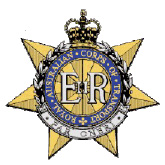
Prior to Federation in 1903
Before Australia became a federeated state in 1903 the individual states had maintained their own military forces. Victoria was the first to raise a logistic unit, which was known as the 'Ordnance, Commissariat and Transport Corps' in 1887; later renamed the Commissariat and Transport Corps. A similar unit known as the Army Service Corps was founded in New South Wales, and upon the formation of the national army in 1901, the predecessor to RACT, the Australian Army Service Corps (AASC) was formed.
No easily accessible history of WW1 operations has been found.
Sometime in 1940, the Directorate of Rail Transportation was formed to coordinate movements between Australian rail networks and roads. In early 1942, a joint services decision was made to make the Army responsible for the supply and operation of small watercraft and dock services, thus the Directorate of Water Transportation (Small Craft) RAE, was formed. This decision was made due to Navy being less able to command and control personnel that were widely dispersed where land forces were operating, particularly in New Guinea.
On 6 August 1945, the Australian Army Transportation Corps (AATnC) was formed by the amalgamation of these directorates, along with Road transport, and all their associated operating units. However, on 7 April 1947, road transport was separated back into the AASC, and the remaining amalgamation become known as the Transportation Service RAE, or RAE(Tn). The RAE(Tn) latter expanded to include the operation of all military terminals.
The railway elements were maintained through an Army Reserve Unit until the late 1960s.
The RACT was formed on 1 June 1973 from an amalgamation of two existing corps: Royal Australian Army Service Corps (RAASC) and Royal Australian Engineers Transportation Service (RAE-TN). From RAASC, RACT gained the responsibilities of road and amphibian transport, air dispatch and postal functions, while from RAE-TN it gained its water transport, terminal and movements roles. The remaining RAASC functions—such as the provision of foodstuffs and petrol, oils and lubricants—were allocated to the Royal Australian Army Ordnance Corps (RAAOC), and RAASC ceased to exist on 31 May 1973. The corps also draws its origins from the Australian Army Transportation Corps, which existed between 1945 and 1947.
Royal Canadian Army Service Corps
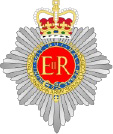
The Royal Canadian Army Service Corps (RCASC) was an administrative and transport corps of the Canadian Army. The Canadian Army Service Corps was established in the Non-Permanent Active Militia in 1901 and in the Permanent Active Militia in 1903.
During World War I, the CASC provided a support element for each Canadian Division, and later on, for the Canadian Corps. With the introduction of motorized vehicles, the CASC carried commodities of a greater range and of greater weights. Motorized transportation also resulted in expanded responsibilities such as driving ambulances and engineer pontoon vehicles, carrying all natures of ammunition, and mobile repair and recovery. In recognition of the services rendered during the Great War, His Majesty King George V authorized the designator “Royal” in 1919.
The RCASC, along with the rest of the Army, underwent a rapid expansion as Canada mobilized for the Second World War. In addition to maintaining transport for the army on land, the RCASC also commanded and maintained a ship-borne freight and patrol company, the Pacific Command Water Transport Company, during World War II. The RCASC provided support to Canadian Soldiers wherever they went; training in Canada and Great Britain, the campaign in north-west Europe, and in the campaign in Italy. The RCASC moved supplies from the rear areas to the frontlines.
During the 1950s, the RCASC committed No. 1 and No. 2 Movement Control Groups, 54 Canadian Transport Company, 28 Motorized Ambulance Company, and 58 General Transport Company to the Korean War. In 1952, 23 Transport Company relieved 54 Transport Company, which was in turn relieved by 56 Transport Company. 3 Transport Company was the last to serve in Korea in 1954.
Unification
When the Army, Royal Canadian Navy, and Royal Canadian Air Force were merged in 1968 to form the Canadian Forces, the administrative Corps of the Army were deactivated and merged with their Naval and Air Force counterparts to form the Canadian Forces' personnel branches.
The RCASC's transport and supply elements were combined with the Royal Canadian Ordnance Corps to form the Logistics Branch The RCASC's clerical trades were merged with the Royal Canadian Army Pay Corps and the Royal Canadian Postal Corps to form the Administration Branch (later merged with the Logistics Branch)
Royal Indian Army Service Corps
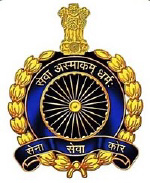
The Indian Army Service Corps (IASC) is a administrative corps and an arm of the Indian Army which handles its logistic support function. It is the oldest and the largest administrative service in the Indian Army. While the history of supply and transport services is as old as the history of organized warfare itself it was in 1760 that the very rudimentary supply and transport organizations of the three presidencies of the East India Company were brought under the council of a single authority.
The origin of the corps go back to 1760 when a Commissariat used to exist in the administrative component of the armies of the Presidencies of Bengal, Madras and Bombay. In 1878 the separate Commissariats were amalgamated into a single entity and then in 1901 it was renamed the Supply and Transport Corps. During the First World War the corps became a permanent component of the British Indian Army and was renamed the Indian Army Service Corps in 1923. In 1935 the corps was granted the 'Royal' prefix and became known as Royal Indian Army Service Corps (RIASC).
fter India gained independence in 1947, the corps underwent further expansion and by 1948 Indian Catering Corps and Indian Army Corps of Clerks were amalgamated into the corps. The Food Testing Laboratories were also placed under the control of RIASC. On 8 December 1950, after India became a republic, the corps dropped the use of the 'Royal' prefix and was once again renamed the Indian Army Service Corps. Since that day the corps has celebrated its Raising Day on 8 December.
Role
The ASC is mainly responsible for the provisioning, procurement and distribution of Supplies of food ration, fresh & dry edible items, FOL(Fuels, oil, lubricants), Hygiene Chemicals and items of Hospital Comforts to Army, Air Force and when required for Navy and other para military forces. The operation of Mechanical Transport except first line transport and fighting vehicles and the provision and operation of first and second line Animal Transport is also the responsibility of the ASC. The other responsibilities include carriage and distribution of ammunition including mines, forward of the Corps Maintenance Area in the field in case of plains, and forward of Divisional Maintenance Area in case of mountain formation, packing of commodities for supply, loading of aircraft and ejection of loads, training and provisioning of clerks for all branches of staff at formation headquarters and the training and provisioning of catering staff in the army. This Corps is a versatile one designed for the role with wide parameters for multifarious activities of immediate concern to the troops. The Corps also handle postal services in forward areas.
Royal New Zealand Army Logistic Regiment




Cap badges from left to right: NZASC1910-47, RNZASC 1946-1955, RNZASC 1955-79, RNZCT 1979-96
History
The New Zealand Gazette of 12 May 1910 advised that the New Zealand Army Service Corps (NZASC) was formed and became a fully designated component of the defence forces of New Zealand. In 1946 the prefix "Royal" was approved in recognition of the Royal New Zealand Army Service Corps' (RNZASC) service during the 1939–45 war and the occupation of Japan.
Although overshadowed by 16 Field Regiment RNZA's contribution to the 1950–54 Korean War, New Zealand also contributed 10 Company, RNZASC as part of Kayforce.
On 12 May 1979, the RNZASC ceased to exist and the responsibilities of road, transport, air dispatch, postal functions and catering were handed over to the Royal New Zealand Corps of Transport (RNZCT) who were formed on 12 May 1979. The responsibilities of provision of foodstuffs and POL (petrol oil lubricants) was handed over to the Royal New Zealand Army Ordnance Corps (RNZAOC).
From 1974 to 1989 the RNZASC/RNZCT provided the New Zealand Transport Squadron and a Catering Platoon to the New Zealand Force South East Asia in Singapore.
On 9 December 1996 the RNZCT was disbanded and was absorbed into the Royal New Zealand Army Logistic Regiment (RNZALR).
South African ‘Q’ Corps
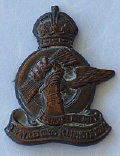
Formation
The South African Service Corps, which was developed during the First World War, the South African Ordnance Corps and the South African Administrative, Pay and Clerical Corps were replaced by the 'Q' Services Corps and the 'T' (Technical) Services Corps in terms of Proclamation 276 of 10 November 1939.
The 'Q' Services were vastly expanded during the Second World War, providing numerous services for the combatant forces, including the provision of petroleum, oil and lubricants (POL), rations, ammunition, stationery, clothing and equipment and other supplies, as well as providing transport through a large number of motor transport (MT) companies. Duties also involved the running of numerous establishments such as field bakeries and butcheries.
By April 1941, 'Q' Services had already deployed more than 7,000 men for the East African Campaign alone.
After the war, pay was also handled by the Corps.
The 'Q' Services Corps was replaced by the Administrative Services Corps (ASC) in November 1949. The ASC was responsible for supply and transport services other than armament and technical stores.
References
Author |
Title |
Year |
Publisher |
Location |
Remarks |
Anon |
156 (Merseyside & Greater Manchester) Transport Regiment RCT(V): regimental history. |
1981 |
North West Publications Ltd. |
Liverpool |
|
Anon |
Royal Army Service Corps |
1962? |
NA |
NA |
Found in British Library catalogue |
Arnold Warren |
Wait for the Waggon. The Story of the Royal Canadian Army Service Corps |
1961 |
McClelland and Steward Limited |
|
|
Bennion, A. O., 1916 |
World War II from my point of view |
1998 |
Avon |
London |
ISBN: 186033511X |
Bullock, Humphry, 1899-1959. |
History of the Army Service Corps |
c1976-1977 |
Sterling Publishers |
New Delhi |
Royal Indian Army Service Corps – History, 5 vol |
Bullock, Humphry. |
The Army Service Corps |
1952-c1984 |
Gale and Polden |
Aldershot |
5 vol. |
By various authors |
Short history of the Royal Army Service Corps |
1944 |
Gale & Polden |
Aldershot |
|
Central Mediterranean Forces |
A brief record of units of the Royal Army Service Corps, Royal Indian Army Service Corps, Royal Canadian Army Service Corps, New Zealand Army Service Corps, South African “Q” Services, Polish Army Service Corps. |
1946 |
Central Mediterranean Forces |
|
|
Crew, Graeme Campbell Eley |
The Royal Army Service Corps |
1970 |
Leo Cooper Ltd |
London |
ISBN: 0850520460 |
Dennis, Peter; Grey, Jeffrey; Morris, Ewan; Prior, Robin |
The Oxford Companion to Australian Military History |
1995 |
Oxford University Press |
Melbourne |
ISBN 0-19-553227-9 |
Fortescue, John William, Sir, 1859-1933. |
The Royal Army Service Corps: A history of transport and supply in the British Army |
1930-31 |
Cambridge University Press |
Cambridge |
2 vols, ISBN: 1843427613 |
Fulton, Fergus, 1923-1976 |
A waggoner's war: a motor transport driver's experiences in North Africa and Italy with the Royal Army Service Corps - 1942-45 |
2011 |
Woodfield Pub. |
Bognor Regis |
ISBN : 9781846831164 (pbk.) |
Habesch, David |
The army's navy: British military vessels and their history since Henry VIII |
2001 |
Chatham |
London |
ISBN: 1861761570 |
Heathfield-Robinson, Douglas, 1921- |
Memoirs of a soldier: 30th April 1941-19th September 1946 |
C2005 |
Bound Biographies |
Bicester |
ISBN: 0953497194 |
Kempton, Chris |
Force K6 : the Indian contingent : RIASC mule companies in France & UK 1939-1944 |
2019 |
Chris Kempton |
Gillingham, Kent |
ISBN: 9781527233294 |
Kenyon, Philip |
One small soldier: (multum in parvo): the story of the early and working life of Philip Kenyon, Royal Engineers (1943-1965), Royal Corps of Transport (1965-1976) |
2012 |
Forces & Corporate Publishing Ltd |
Rushden, Northamptonshire |
ISBN: 9780957472501 |
Leland, F. W |
With the M.T. in Mesopotamia |
1920 |
Forster Groom & Co |
London |
|
Maginniss, Clem and Gary Sheffield |
A great feat of improvisation: logistics and the British expeditionary force in France 1939-1940 |
2021 |
Helion and Company Limited |
Warwick, England |
|
Massé, Lt-Col. C. H. |
The Predecessors of the Royal Army Service Corps 1757–1888. |
1948 |
Gale & Polden |
Aldershot |
|
McKenzie-Smith, Graham |
"The Army's Grocers and Truckies: Understanding the Australian Army Service Corps in WW2" |
2015 |
Sabretache. LVI (1, March). Military Historical Society of Australia: 16–22. |
|
ISSN 0048-8933. |
Merritt, Maurice |
Eighth Army driver |
1981 |
Midas |
Tunbridge Wells |
ISBN: 085936282 |
Millen, Julia |
Salute to service: a history of the Royal New Zealand Corps of Transport and its predecessors, 1860-1996 |
1997 |
Victoria University Press |
Wellington N.Z. |
ISBN: 0864733240 |
Nelson, Michael, 1921-1990. |
Captain Blossom soldiers on, or, Run away, someone's coming |
1976 |
New English Library |
London |
ISBN: 0450028682 |
Nuttall, James |
The long journey |
C1993 |
Excalibur |
London |
ISBN: 185634357X |
Palazzo, Albert |
The Royal Australian Corps of Transport: A History of Australian Army Transport 1973–2000. |
2001 |
Australian Military Historical Publications |
Loftus |
ISBN 978-1-876439-80-4. |
Rogers, David, 1954 |
Bullets, bombs and poison gas: supplying the troops on the Western Front 1914-1918 |
2017 |
Helion & Company Limited |
Solihull, West Midlands, England |
ISBN: 9781911512080 (pbk.): |
Royal Army Service Corps |
The story of The Royal Army Service Corps 1939-1945. |
1955 |
G Bell and Sons Ltd. |
|
|
Royal Indian Army Service Corps |
A glossary of Urdu phrases for R.I.A.S.C. officers |
1941 |
Royal Indian Army Service Corps |
Simla |
|
Royal Indian Army Service Corps |
List of articles supplied by the Royal Indian Army Service Corps, with specifications. |
1939 |
Manager of Publications |
Delhi |
|
SCOTT, Kenneth Barstowe Hare |
The Royal Army Service Corps |
1946 |
Lonsdale Publications |
London |
|
Sutton, Brigadier John |
Wait for the Waggon: the Story of the Royal Corps of Transport and its Predecessors 1794–1993. |
1998 |
Leo Cooper |
Barnsley, S. Yorks |
|
Sutton, D. J |
Wait for the waggon: the story of the Royal Corps of Transport and its predecessors, 1794-1993 |
1998 |
Leo Cooper |
Barnsley |
ISBN: 0850526256 |
Sutton, D. J. |
The Story of the Royal Army Service Corps and Royal Corps of Transport 1945-1982 |
1983 |
Leo Cooper in association with Secker and Warburg |
London |
ISBN: 0436506068 |
Tennant, Charles |
My war, my mules and me |
C1986 |
Albyn |
Edinburgh |
ISBN: 0284986682 |
Turpin, Patrick G |
The turn of the wheel: the history of the RASC 1919-1939 |
1988 |
Barracuda |
Buckingham |
ISBN: 0860234282 |
Vidler, Joseph A., 1922 |
I was there |
1998 |
J.A. & M.W. Vidler |
Hythe |
|
Williams, G. |
Citizen soldiers of the Royal Engineers Transportation and Movements and the Royal Army Service Corps, 1859 to 1965 |
1969 |
Institution of the Royal Corps of Transport |
Aldershot |
ISBN: 0950075604 |
Young, Michael, Lieutenant Colonel |
Postcards of the Army Service Corps 1902-1918: Coming of age |
2016 |
Pen & Sword Military |
Barnsley, South Yorkshire |
ISBN: 9781473878136 |
Young, Mike |
Army Service Corps, 1902-1918 |
2000 |
Leo Cooper |
London |
ISBN: 0850527309 |
Museums
The Royal Logistic Corps Museum.
This contains the collections of the founding corps. https://www.royallogisticcorps.co.uk/museum/
Tuesday to Saturday 09:30 to 16:00 (last entry at 15:30)
Free entry and car parking
Worthy Down, Winchester, SO21 2RG
Royal Australian Corps of Transport Museum
https://aumuseums.com/vic/goulburn/royal-australian-corps-transport-museum
Royal Canadian Army Service Corps Museum
See https://themilitarymuseums.ca/
Royal Indian Army Service Corps Museum
There does not appear to be a separate museum for the RIASC: https://indianarmedforcesmuseums.gov.in/
Royal New Zealand Army Service Corps Museum
See https://www.armymuseum.co.nz/
South African ‘Q’ Corps Museum
Again, there does not appear to be a separate museum: https://ditsong.org.za/en/?venue=national-museum-of-military-history
|
| Registered Charity No 290944 | Company Limited by Guarantee No 1862659 |